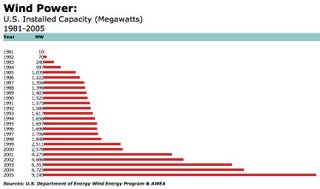 Long known as a top oil- and natural gas-producing state, Texas now has another energy title under its belt: the nation's top producer of wind energy.
Long known as a top oil- and natural gas-producing state, Texas now has another energy title under its belt: the nation's top producer of wind energy.
Texas installed wind power capacity now stands at 2,370 megawatts (MW), enough to power 600,000 average-sized homes a year, according to a midyear report released Tuesday by the American Wind Energy Association (AWEA). That puts Texas slightly ahead of California (with 2,323 MW of capacity), the nation's leader since 1981. The total U.S. capacity is now 9,971 MW, according to an Associated Press article [via Environmental News Network].
So far this year, Texas has added 375 MW, which makes up 46 percent of the total 822 MW brought online nationwide, AP reports.
Last year, wind energy generation grew 35 percent nationwide, adding 2,431 MW, falling a bit short of the projected 2,500 MW. The wind association believes it can add 3,000 MW nationwide this year, even if that means another 2,178 MW by year's end.
"There are substantially more developments in the pipeline," said Randall Swisher, AWEA's executive director. "We are just about where we thought we would be in terms of appearing to be on course for another industry record for the year."
Texas had slowly been creeping up on California the past few years, so taking the top spot was inevitable, wind energy consultants said. A favorable business and permitting climate along with plentiful land have attracted investments from as far away as Ireland.
Mike Sloan, president of Austin-based Virtus Energy Research Associates, estimates about $2 billion will be invested in wind energy development statewide this year and about $4.5 billion nationwide.
"Wind energy is a prudent hedging vehicle," Sloan said. "So many policy leaders around the country see the importance of energy diversity and how homegrown renewables make a lot of sense."
Next, Texas wants to be home to more than just the place with the most wind energy generation capacity, said Jerry Patterson, the state's land commissioner. Patterson said he believes Texas can be an industry hub, just as it has been for oil and natural gas.
In addition to significant statewide developments, Texas has signed two agreements since last fall with developers to build offshore wind farms along the Gulf Coast [see previous post].
Wind energy, however, still has a long way to go before it's considered conventional rather than an alternative. It makes up about 1 percent of the nation's electricity, AP reports. To become an attractive investment, wind farm developers often rely on federal tax credits.
For the next 18 months, projects coming online receive the federal Production Tax Credit (PTC) - recently extended to 2007 in the Energy Policy Act of 2005 - amounting to 1.9 cents per kilowatt hour of wind energy produced by the project. Those incentives are good for the first 10 years of production.
But there is no guarantee that any projects completed after 2007 will receive those tax credits and that discourages long-term development, energy officials said. The start and stop history of the PTC - which has repeatedly expired and been reinstated over the past several years - has created a cycle of boom-and-bust in the wind industry.
[Check out the graph below (click to enlarge) and you'll see what I mean. Look at the past seven years (1998-2005): when the PTC expired, you'll see very little growth while years in which the PTC was active see a sharp increase in installed capacity] Energy consultant Bruce Bailey is optimistic though, that some kind of subsidy will be available after 2007. Bailey, who is president of AWS Truewind LLC in Albany, N.Y., said federal lawmakers are becoming increasingly more bullish on this renewable energy and won't likely let it expire without an extension.
Energy consultant Bruce Bailey is optimistic though, that some kind of subsidy will be available after 2007. Bailey, who is president of AWS Truewind LLC in Albany, N.Y., said federal lawmakers are becoming increasingly more bullish on this renewable energy and won't likely let it expire without an extension.
[A hat tip to Diane Zipper]
Tuesday, July 25, 2006
Texas Leads in Wind Power, Passes California with 2,370 MW
Posted by
Jesse Jenkins
Ads at www.WattHead.org:
Wind Turbine Training
Solar Panels and Kits for the Home
Solar Energy Products and Home Solar Panels
Wind Turbine Training
Solar Panels and Kits for the Home
Solar Energy Products and Home Solar Panels
Subscribe to:
Post Comments (Atom)













No comments:
Post a Comment